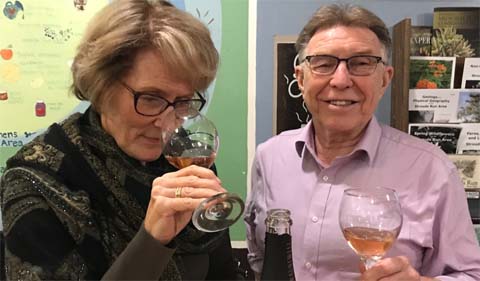Whether in the form of reviews in the mass-media and in dedicated magazines and websites such as the Wine Spectator, or in wine blogs, or in label-scanning apps such as Vivino, or even in millions of user reviews on sites such as Cellar Tracker, wine tasting notes are ubiquitous and immensely influential.
For Dr. David Bell, Associate Professor and Chair of Linguistics and Dr. Theresa Moran, Director of Food Studies, tasting notes are prime data for the study of linguistic style — how the stylistic choices in language that wine critics make reflect differing philosophies about the nature of wine.
They authored “Comparing the wine tasting notes of Jancis Robinson and Terry Theise: A stylistic analysis” in Text & Talk.
Bell and Moran examined the linguistic style of the tasting notes of two prominent wine writers with contrasting wine philosophies: Jancis Robinson and Terry Theise. Robinson is credited with a straight-talking, demystifying approach to wine, while Theise urges that we “remystify” wine, equating demystification with dumbing down.
For the purposes of comparison, Bell and Moran built a corpus of Robinson’s and Theise’s tasting notes of German and Austrian 2012 vintage wines, so the two wine critics are essentially reviewing the same wines. Here are examples of their tasting notes.
- Robinson: “Looks quite dense. Quite funky nose. Bone dry. Not expensive. Smoky fruit on the palate. A tad hard on the end but very well intentioned.”
- Theise: “This is a fuder Mosel classic, with the salts and mints of 2012 and the chocolatey tone from cask, plus balsam and wintergreen and apples and lemon cream.”
Bell and Moran found that Robinson’s demystification is manifested by adherence to the traditional rhetorical structure of tasting notes according to nose, palate, and finish; verbless clauses; and limited use of descriptors such as minerally and chocolatey. Theise’s remystification is manifested in more non-conventional rhetorical structure, additive, people-centered grammatical structure, and use of diverse descriptors.
In their research on the varying linguistic styles of tasting notes, Bell and Moran were struck by the importance of context in wine tasting both in terms of the appreciation of a wine and in terms of the rhetorical and grammatical structure of the tasting note.
Theise does his tasting at the vineyards of individual producers, which allows him to edit his notes and respond to external stimuli as in the following tasting note: “Here’s this little blackbird singing its tiny lungs out, all that energy and melody coming from such a tiny, delicate body, and in the glass there’s a wine with 8 percent alcohol, all that energy and melody coming from such a tiny, delicate body.”
Robinson’s tastings, on the other hand, are done at tasting events organized by wine grower associations in Germany and Austria and wine retailers and trade commissions in London. She often tastes up to 100 different wines in a day, which means that her notes are written in real time with little chance to edit. Robinson is the voice of the utilitarian and functional, determined to provide the clearest, most accessible information that will help the consumer choose a particular wine.




















Comments